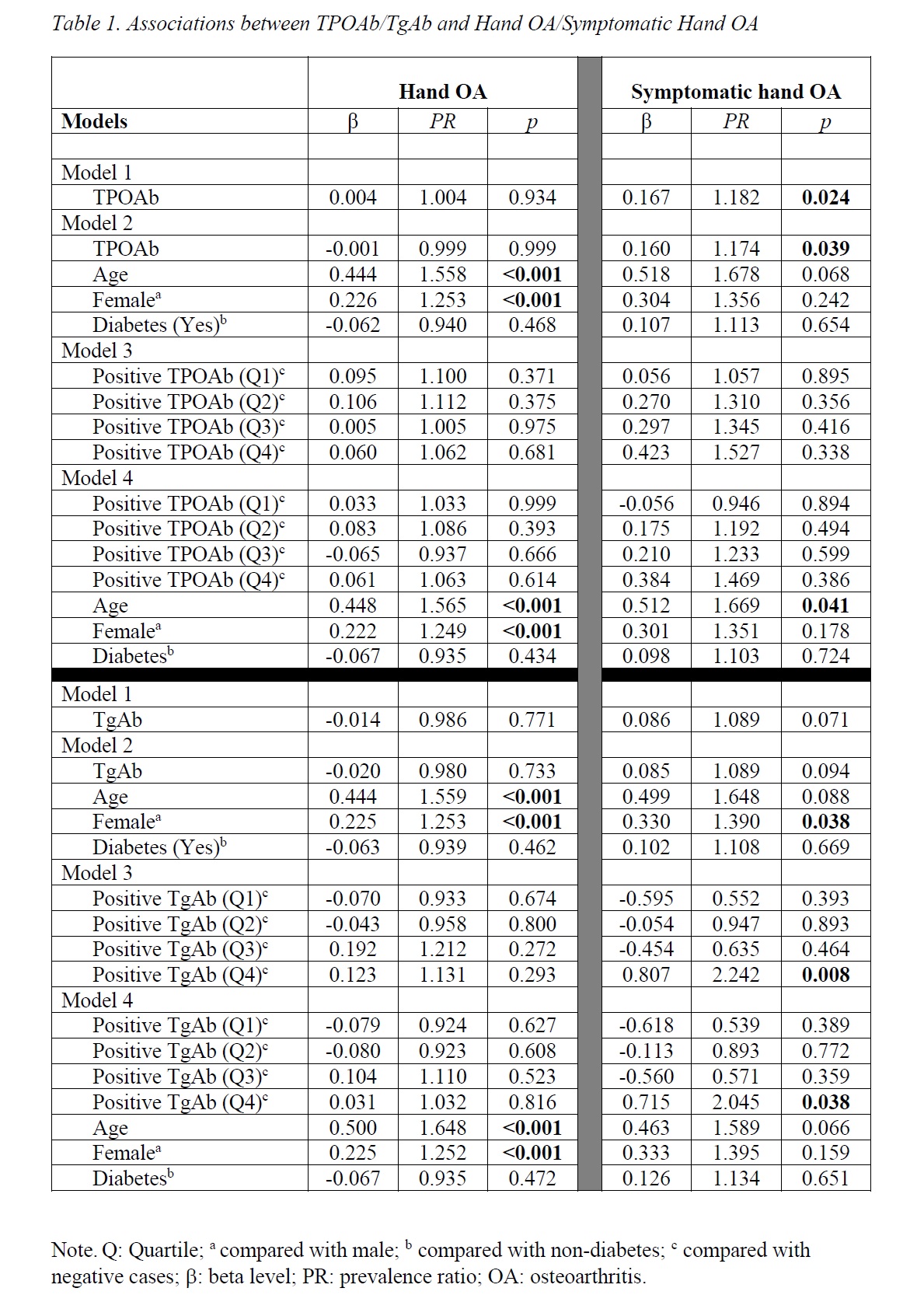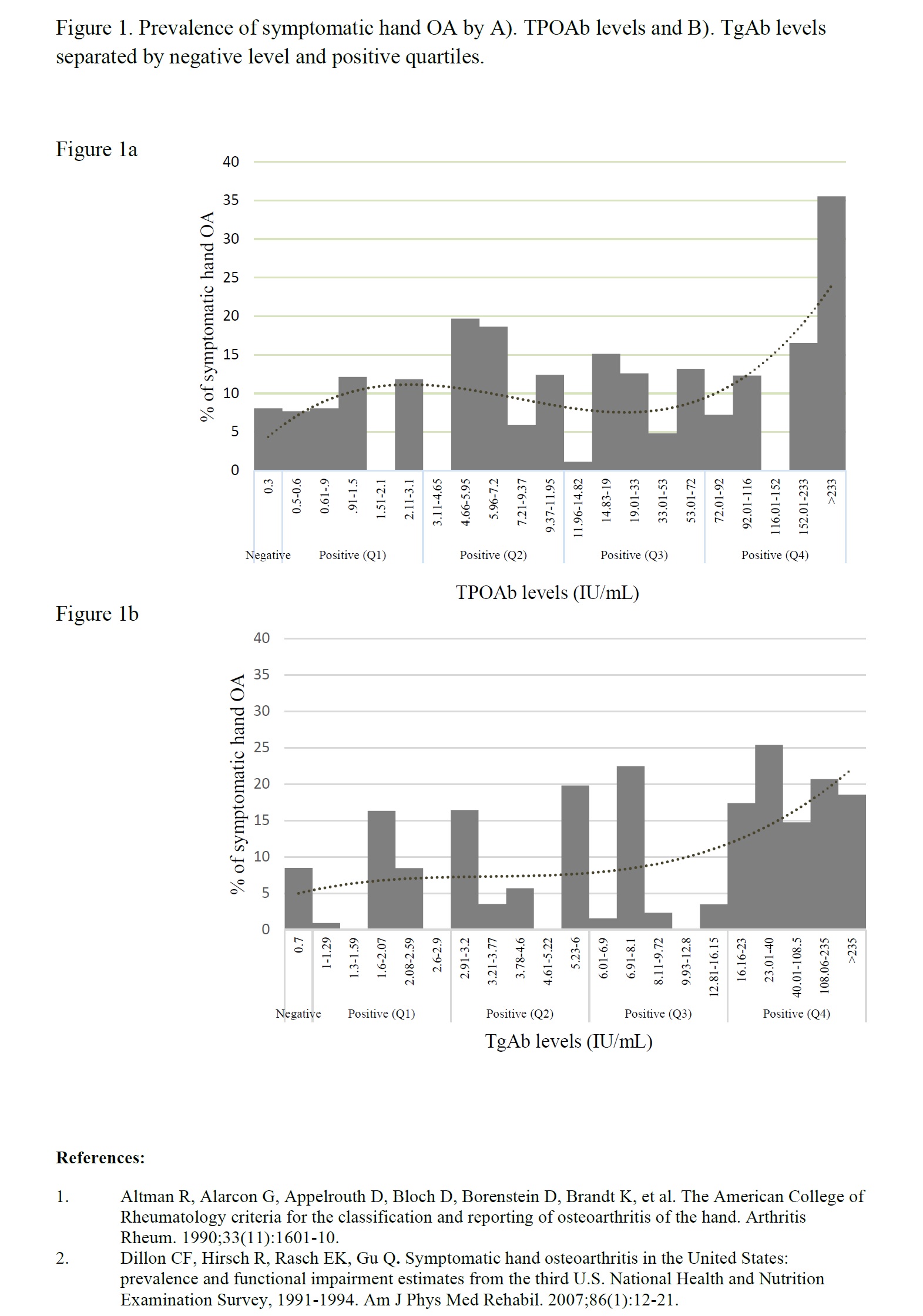Session Information
Session Type: Poster Session B
Session Time: 9:00AM-11:00AM
Background/Purpose: Osteoarthritis (OA) of the hand is associated with the presence of bony deformities in the proximal interphalangeal joints, distal interphalangeal joints, and first carpometacarpal joints, frequently with joint pain and stiffness (1). The factors conferring risk and determining the joint distributions in hand OA are not well understood. Due to similarities in the epidemiology of hand OA and autoimmune thyroid disease (AITD) we investigated for the first time, a possible association between the two conditions in participants representative of the US population. The purpose of the study was to examine whether the AITD autoantibodies, anti-thyroid peroxidase antibody (TPOAb) and anti-thyroglobulin antibody (TgAb), associate with hand OA and symptomatic hand OA in the Third National Health and Nutrition Examination Survey (NHANES III).
Methods: NHANES III interviewed a sample of 33,994 participants, 3128 of whom were aged 60 years and over in Phase 2 (1991 – 1994) of the study where data for osteoarthritis were collected. A total of 2429 persons ≥60 years of age had no missing data for TPOAb and TgAb. Clinical hand OA (46.6% of participants) was defined using the American College of Rheumatology Classification Criteria modified for the NHANES III data set following the experience of Dillon et al. (2). Symptomatic hand OA (8.6% of participants) was defined as hand OA with the presence of chronic hand pain recorded as the presence of a “yes” response to the question, “Have you ever had pain in your hands on most days for at least 6 weeks? This also includes aching and stiffness”. Data on hand OA or symptomatic hand OA were examined with respect to their associations with TPOAb and TgAb. Log binomial and modified Poisson regression models were fit to examine the associations between the anti-thyroid autoantibodies, and hand OA or symptomatic hand OA.
Results: Higher levels of TPOAb were associated with a higher prevalence of symptomatic hand OA in the unadjusted (PR=1.182, p=0.024) and adjusted models, after controlling for age, gender, and diabetes (PR=1.174, p=0.039). The significance of the association was no longer observed when positive TPOAb was classified into four levels and was compared with negative TPOAb. TgAb analyzed as a continuous variable showed a trend to being positively associated with symptomatic hand OA (p< 0.10) in both the unadjusted and adjusted models. When positive TgAb was stratified as a categorical variable with four levels and compared with negative TgAb the highest quartile was associated with a higher prevalence of symptomatic hand OA than negative TgAb in the unadjusted (PR=2.242, p=0.008) and adjusted models (PR=2.045,p=0.038). There was no significant association between TPOAb or TgAb and hand OA.
Conclusion: Higher levels of TPOAb may be associated with the presence of symptomatic hand OA in persons ≥60 years. Persons ≥60 years with the highest quartile levels of TgAb may be more likely to present with symptomatic hand OA. Neither TPOAb nor TgAb was significantly related to the presence of hand OA.
To cite this abstract in AMA style:
Tagoe C, Wang W. Autoimmune Thyroid Disease Associates with Symptomatic Hand Osteoarthritis in Older Persons in the Third National Health and Nutrition Examination Survey [abstract]. Arthritis Rheumatol. 2023; 75 (suppl 9). https://acrabstracts.org/abstract/autoimmune-thyroid-disease-associates-with-symptomatic-hand-osteoarthritis-in-older-persons-in-the-third-national-health-and-nutrition-examination-survey/. Accessed .« Back to ACR Convergence 2023
ACR Meeting Abstracts - https://acrabstracts.org/abstract/autoimmune-thyroid-disease-associates-with-symptomatic-hand-osteoarthritis-in-older-persons-in-the-third-national-health-and-nutrition-examination-survey/


